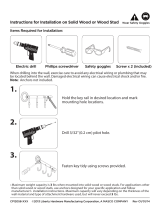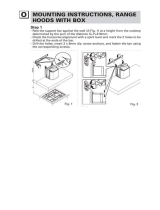
Before you begin--Read these insuucfions completely and careflflly.
IMPORTANT: Save these insuuctions for local inspector's use.
IMPORTANT: OBSERVE ALL GOVERNING CODES AND ORDINANCES.
NOTE TO INSTALLER: Be sure to leave these instructions with the ConsumeL
NOTE TO CONSUMER: Keep these insuucfions with your Owner's Manual for
flmlre reference.
V!lw_,_:mh,[_This appliance must be properly grounded. See "Electrical Supply", page 4. I
If you have questions concerning the
installation of tiffs product, call the GE Answer
Center _>Consumer Information Service at
800.626.2000, 24 hours a day, 7 days a week.
If you received a damaged vent hood, you
should contact your dealeL
CAUTION!
Due to the weight and size of these vent hoods
and to reduce the risk of personal i_jury or
damage to the product, TWO PEOPLE ARE
REQ,UIRED FOR PROPER INSTAI,IATION.
_i_ARNING!
To reduce the risk of fire or elecuic shock,
do not use tiffs range hood with any external
solid-state speed conuol device. Any such
alteration flom original factory wiring could
result in damage to the unit and/or create an
elecuical safety hazard.
To reduce the risk of fire and to properly
exhaust air, be sure to duct air outdoors. Do
not vent exhaust air into spaces wittfin walls or
ceilings or into attics, crawl spaces or garages.
_i_SkRNING: TO REDUCE THE RISK OF FIRE,
USE ONIX METAl, DUCTWORK
TO REDUCE THE RISK OF FIRE, EI,ECTRIC
SHOCK OR INJURY TO PERSONS,
OBSERVE THE FOI,I,OWING:
A. Use tiffs unit only in the manner intended
by the manufacturer. If you have any
questions, contact the manufacturer.
B. Before servicing or cleaning unit, switch
power off at service panel and lock service
panel to prevent power flom being switched
on accidentally. If the service panel cannot be
locked, fasten a tag or prominent warning
label to the panel.
For general ventilating use only. Do not use
to exhaust hazardous or explosive materials
and vapors.
Installation work and elecuical wiring must be
done by qualified person (s) in accordance with
all applicable codes and standards including
fire-rated construction.
Sufficient air is needed for proper combustion
and exhausting of gases through the flue
(clfimney) of tirol burning equipment to
prevent back drafting. Follow the heating
equipment manufacturer's guidelines and
safety standards such as those published by the
National Fire Protection Association (NFPA),
and the American Society for Heating,
Refligevadon and Air Conditioning Engineers
(ASHRAE), and the local code authorities.
Contents Design Information
Model Available ................................................................................................................................... 3
Optional Accessories ........................................................................................................................... 3
Product Dimensions & Clearances .................................................................................................... 3
Advance Planning ............................................................................................................................... 4
Electrical Supply .................................................................................................................................. 4
Installation Preparation
Duct Fittings ........................................................................................................................................ 5
Tools and Materials Required ............................................................................................................. 6
Step 1: Remove the Packaging ............................................................................................................ 6
Installation
Step 2: Check Installation Hardware .................................................................................................. 7
Step 3: Ductwork, Wiring, Hood Attachment I,ocations .................................................................. 7
Step 4: Install Mounting Brackets ....................................................................................................... 8
Step 5: Install the Hood ...................................................................................................................... 8
Step 6: Install Duct Bracket ................................................................................................................. 9
Step 7: Connect Ductwork ................................................................................................................ 10
Step 8: Connect Elecuical ................................................................................................................. 10
Step 9: Install Decorative Duct Cover and Utility Bars .................................................................... 10
Step 10: Install Filters ........................................................................................................................ 11
Step 11: Finalize Installation ............................................................................................................. 11













